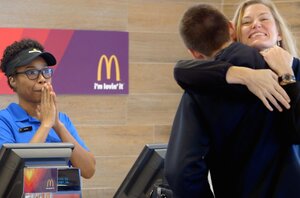McDonald's 'Pay with Lovin" ads not making people love McDonald's
McDonald’s 'Pay With Lovin’ campaign launched during the Super Bowl got people talking, but not necessarily positively about McDonald's, according to a recent survey.

This photo provided by McDonald's shows a portion of their 60-second "Pay With Lovin'' spot that's part of a Valentine’s Day promotion that started the day after Super Bowl XLIX.
McDonald's/AP/File
McDonald’s “Pay With Lovin’” campaign launched during the Super Bowl got people talking, but not necessarily positively about the chain, according to a study released today from YouGov BrandIndex.
Giving free meals in exchange for “random acts of lovin’” earned McDonald’s the highest word-of-mouth gain of all Super Bowl advertisers. The report finds 29% of adults saying they talked about McDonald’s with friends and family over the past two weeks. This is up from the 24% level McDonald’s had before the campaign
On the day the campaign broke (Feb. 1), 36% of consumers 18 and older said they would consider McDonald’s for their next QSR food purchase. The good intentions not only lasted, they grew: 11 days later 39% were saying they would consider McDonald’s. How well purchase consideration was converted to actual additional purchases (offsetting more than 1 million free meals) won’ be known until McDonald’s February sales results next month.
But the report does conclude that consumer perceptions of the McDonald’s brand improved very little as a result of the campaign. YouGov BrandIndex’s Buzz score comes from responses to the question, “If you heard anything about the brand in the last two weeks, through advertising, news or word of mouth, was it positive or negative?” McDonald’s Buzz score actually dipped briefly to -1 (slightly negative) before rising to a 3 by Valentine’s Day.
YouGov BrandIndex interviews 4,300 people each weekday from a representative US population sample, more than 1.5 million interviews per year. Respondents are drawn from an online panel of more than 2MM individuals.

